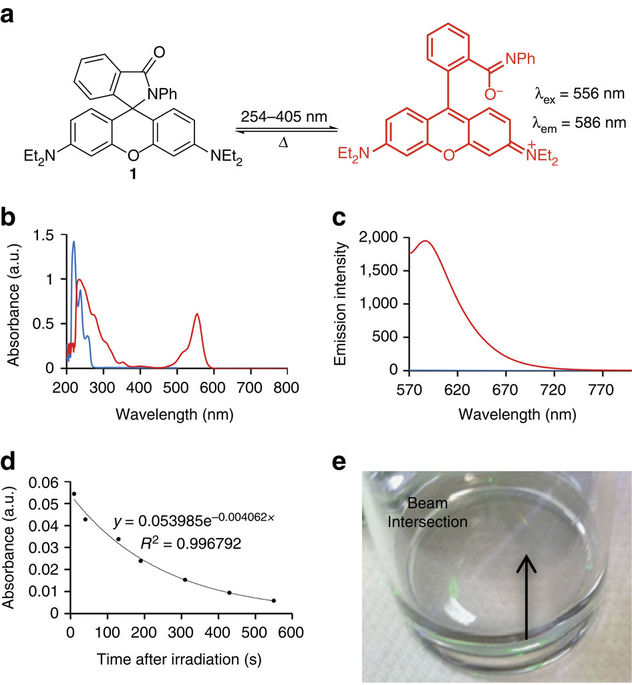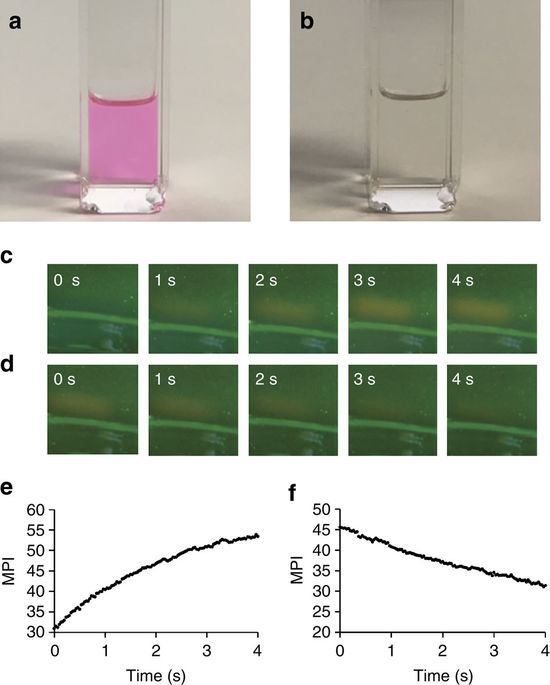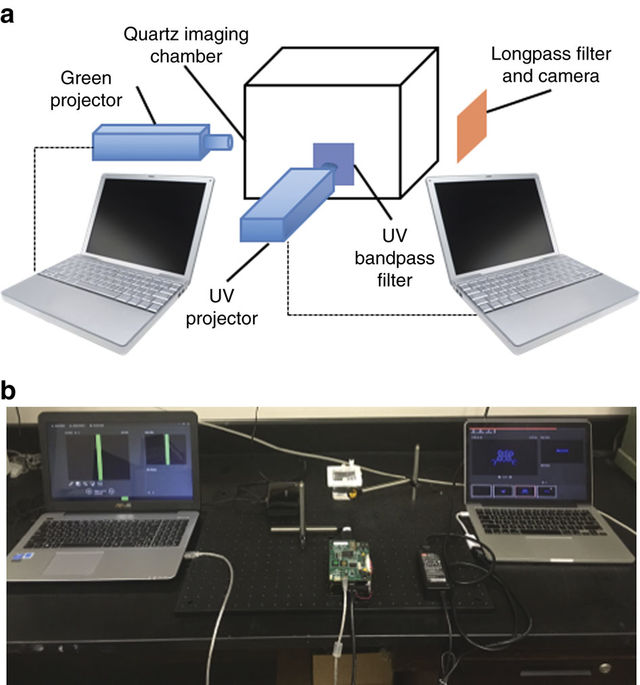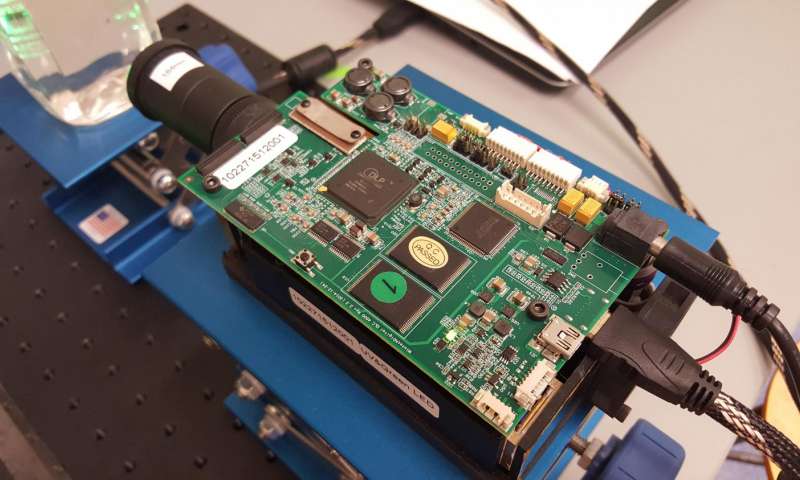博文
Nat. Comm.:分子控制3-D成像,比星球大战更精彩
 精选
精选
|||
Nat. Comm.:分子控制3-D成像,比星球大战更精彩
诸平

Figure 1: Spectroscopic properties of N-phenyl spirolactam rhodamine B 1.(a) Reaction scheme for photoactivatable fluorescence of 1. (b) Absorbance spectrum of 50 μM 1 in CH2Cl2 before (blue trace) and after (red trace) irradiating with 0.26 mW cm−2 254 nm light for 5 min. (c) Emission spectrum of 50 μM 1 in CH2Cl2 before (blue trace) and after (red trace) irradiating with 0.26 mW cm−2 254 nm light for 5 min. λex=556 nm. (d) Thermal fading kinetics of the absorption at 556 nm of 5 mM 1 in CH2Cl2 after irradiating with 1.0 mW cm−2 315 nm light for 90 s. (e) Image of a vial containing 5 mM 1 in CH2Cl2 and two intersecting beams from 532 nm and a 405 nm laser pointers. Absorbance data is reported in arbitrary units (a.u.).

Figure 2: Substoichiometric triethylamine increases the rate of thermal fading.(a) Image of 5 mM 1 in CH2Cl2 after irradiating with 0.26 mW cm−2 254 nm light for 5 min. (b) Image of 5 mM 1 in CH2Cl2 after irradiating with 0.26 mW cm−2 254 nm light for 5 min, followed by addition of 1 drop of triethylamine. (c) Images of 5 mM 1 in CH2Cl2 and 5 p.p.m. triethylamine (36 μM) irradiated with 0.40 mW cm−2 385 nm and 2.0 mW cm−2 525 nm light for 0, 1, 2, 3 and 4 s. (d) Images of 5 mM 1 in CH2Cl2 and 5 p.p.m. triethylamine (36 μM) after irradiating with 0.40 mW cm−2 385 nm and 2.0 mW cm−2 525 nm light for 4 s, and then removing the 385 nm irradiation for 0, 1, 2, 3 and 4 s. (e) Plot of MPI of illuminated cross section versus time for the photoactivation experiment shown in c. (f) Plot of MPI of irradiated cross section versus time for the thermal fading experiment shown in d.

Figure 3: Design of a first-generation 3D Light PAD.(a) Schematic of the system architecture. (b) Photograph of the first-generation 3D Light PAD.

Figure 4: Optical filters improve image quality.A ultraviolet square was projected from the Pro4500 ultraviolet projector and a green bar was projected from the Miroir 720p picoprojector into a solution of 1 in CH2Cl2 containing 1 p.p.m. (7.2 μM) triethylamine using (a) no filters, (b) 515 nm longpass filter, (c) 550 nm longpass filter, (d) 590 nm longpass filter, (e) ultraviolet bandpass filter (240–395 nm), (f) ultraviolet bandpass filter (240–395 nm) and 515 nm longpass filter, (g) ultraviolet bandpass filter (240–395 nm) and 550 nm longpass filter, (h) ultraviolet bandpass filter (240–395 nm) and 590 nm longpass filter. Images were generated using 2.0 mW cm−2 525 nm light and 0.40 mW cm−2 385 nm light (no bandpass filter) or 0.27 mW cm−2 385 nm light (with bandpass filter).

Figure 5: Characterization of the first-generation 3D Light PAD.
(a) Images of voxels of increasing volume. (b) Images of bars with increasing separation in the vertical and horizontal direction. (c) Plot of MPI for on and off state of 5 mM 1 in CH2Cl2containing 36 μM triethylamine versus cycle number. Images were generated using 2.0 mW cm−2 525 nm light and 0.27 mW cm−2 385 nm light.

Figure 6: Representative images generated using the first-generation 3D Light PAD.
(a) SMU Mustang, (b) ‘Lippert Lab’ text, (c) photograph of one of the authors next to a saguaro cactus, (d) N-phenyl spirolactam rhodamine B 1, (e) pyramid, (f) cube, (g) cylinder, (h) N-phenyl spirolactam rhodamine 1 with 3D representation of stereochemistry, (i) chair, (j) table, (k) stacked circles, (l) stacked triangle and circle.

Fig.7 The set-up for the SMU 3-D light pad includes this ultraviolet projector as well as a visible projector. The two project patterns of light into a chamber of photoactivatable dye. Wherever the UV light intersects with the green light it generates a 3-dimensional image inside the chamber. Credit: SMU
据南卫理公会大学(Southern Methodist University,简称SMU)2017年7月11日提供的消息,该大学的研究人员通过对光线的构建就可以实现科学家类似于在多少年之前在《星球大战》(Star Wars)电影中看到3-D效果之梦想。相关研究结果于2017年7月11日在《自然通讯》(Nature Communications)杂志网站发表——Shreya K. Patel, Jian Cao, Alexander R. Lippert. A volumetric three-dimensional digital light photoactivatable dye display(点击可以免费下载原文). Nature Communications, 2017, 8, Article number: 15239. DOI: 10.1038/ncomms15239.
图1~图6是来自论文的图片,图7就是SMU提供的照片。为SMU的三维光(3-D light)做准备,需要垫补包括紫外线投影仪以及可见光投影仪。2种模式的光线入射到一个光活化染料室,无论在何处紫外线都会与绿色光线相交,在光活化染料室内会生成一个三维图像。SMU领导这项研究的化学家亚历山大·利伯特(Alexander Lippert)说,此项新技术采用光电开关分子,该分子可以使人们从360度来审视活生生的三维光结构。
将光线塑造成无限容积对象的经济方法将会在各种各样的领域大有用场,从从生物医学成像、教育和工程、再到电视、电影、视频游戏乃至更多领域。
亚历山大·利伯特说:“我们的想法是使用化学和特殊的光电开关分子进行三维显示,提供一种360度的视觉景观,但是,这不是一种全息图,其实就是一种三维结构光( three-dimensionally structured light)。”此项研究成果的关键技术是一种分子,这种分子在紫外线存在与否的反应条件下,会在荧光和非荧光之间进行切换。
此项新技术并非是一个全息图,而且不同于3D电影或3D的电脑设计。那些是平面显示需要使用双筒望远镜,借助通过双筒镜两眼差异或线性透视图使物体显得有立体感,而事实上它们只有高度和宽度,缺乏一个真正的体积要件。
亚历山大·利伯特说:“当你看到一个3 -D电影时,其实就是在自欺欺人,看到的3-D效果是欺骗自己的大脑,是因为3-D效果是你的两只眼睛看到不同图像的结果。但是,我们的显示并是不欺骗你的大脑,是在三维实际中已经将化学用于结构光,所以没有偷梁换柱的‘技巧’,就是一种真正的三维结构。我们称之为三维数字光光可活化染料显示(3-D digital light photoactivatable dye display),简称三维光垫(3-D Light Pad),更像在现实生活中我们所看到的。”
SMU三维光垫的核心技术就是一种“光电开关”分子( "photoswitch" molecule),这种分子当受到一束紫外线照射时,它可以从无色切换到荧光。研究人员发现一种调整光电开关分子的热褪色(断开开关)速率的化学创新方法,就是添加化学胺基如通过三乙胺等。
通过化学方法探索光与物质的相互作用,专门从事荧光和化学发光研究的专家亚历山大·利伯特说,现在SMU新型三维光垫(SMU 3-D Light Pad)技术的关键是无限制应用,考虑到许多可能的用途。例如,应用此项技术会使电话会议给人的感觉更像是面对面的会议;建筑业和制造业也同样可能受益于3-D渲染,对实时空间信息进行观察和讨论。至于在军事领域中的应用,使用此项技术可能包括陆地、空中、水下甚至在太空战略战术的三维立体响应。
体积3-D可造福于医学领域
亚历山大·利伯特说:”用真正的三维核磁共振成像结果,放射科医生可以更容易识别异常如癌症。我认为这将对人类健康产生重大影响,因为一个真正的三维图像能提供更多的信息。”
与3-D印刷不同,体积3-D结构光很容易动画设计和易变来适应设计上调整。而且,多个人可以同时审查立体显示的不同方位,可以令人信服地设想游乐园、广告、3-D电影和3-D游戏等,在视觉上更加逼真、引人注目以及令人愉悦。
此项研究成果的第一作者Shreya K. Patel和第二作者曹健(Jian Cao音译)两位均系SMU化学系的学生。
灵感源于影片诱发
亚历山大·利伯特认为,光塑造成体积动画三维立体图像的想法来自童年迷恋电影‘星球大战’(Star Wars)。尤其是当R2-D2项目莉亚公主的全息图使他受到启发。他对三维立体的浓厚兴趣一直持续到“《星际迷航:下一代》(Star Trek: The Next Generation)中的全息甲板。”网络上也有亚历山大·利伯特从儿时观看《星球大战》到成为SMU化学家的视频,更多信息请注意浏览原文或者相关报道:
Researchers use laser-generated bubbles to create 3-D images in liquid
Better than Star Wars: Chemistry discovery yields 3-D table-top objects crafted from light
Abstract
Volumetric three-dimensional displays offer spatially accurate representations of images with a 360° view, but have been difficult to implement due to complex fabrication requirements. Herein, a chemically enabled volumetric 3D digital light photoactivatable dye display (3D Light PAD) is reported. The operating principle relies on photoactivatable dyes that become reversibly fluorescent upon illumination with ultraviolet light. Proper tuning of kinetics and emission wavelengths enables the generation of a spatial pattern of fluorescent emission at the intersection of two structured light beams. A first-generation 3D Light PAD was fabricated using the photoactivatable dye N-phenyl spirolactam rhodamine B, a commercial picoprojector, an ultraviolet projector and a custom quartz imaging chamber. The system displays a minimum voxel size of 0.68 mm3, 200 μm resolution and good stability over repeated ‘on-off’ cycles. A range of high-resolution 3D images and animations can be projected, setting the foundation for widely accessible volumetric 3D displays.
https://blog.sciencenet.cn/blog-212210-1065980.html
上一篇:华盛顿大学的无电池手机(附原文)
下一篇:光电转换效率达44.5%的太阳能电池